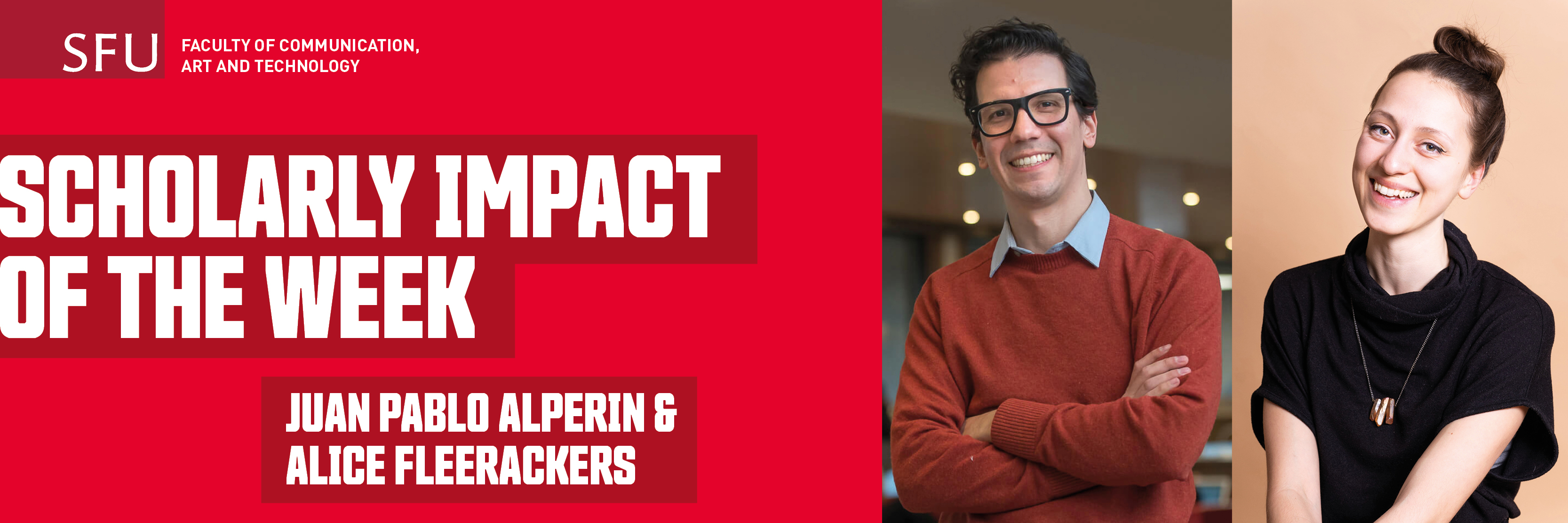
Throughout the pandemic, quick access to scientific findings has been essential to keeping the public informed. The use of preprints—scientific manuscripts posted on open access sources like bioRxiv and medRxiv prior to peer review—was quickly adopted by media outlets. SFU researchers caution that while access to research is imperative, publishing unverified science comes with risks.
Juan Pablo Alperin is an associate professor in the Publishing Program, the Associate Director of Research for the Public Knowledge Project, and co-director of the Scholarly Communications Lab. Alice Fleerackers is a PhD student in the Scholarly Communications Lab, where she studies how uncertain health science is communicated and shared online. Their article, Communicating Scientific Uncertainty in an Age of COVID-19: An Investigation into the Use of Preprints by Digital Media Outlets was one of the top-cited academic papers from SFU in 2021.
Fleerackers led the investigation into media outlets’ use of preprints in the first few months of the pandemic. Sharing the quick and collective discoveries of the scientific community with the public has helped save lives. However, the use of research preprints also meant unproven ideas about COVID-19 were quickly shared as well. In addition, of over 450 media articles studied, including those from prominent sources such as the New York Times, only about half mentioned the research was unverified.
We talked with Alperin and Fleerackers about their peer-reviewed paper.
Can you talk about the role of preprints in sharing information?
While our study examined how journalists used preprints in their work, we should remember that the primary users of preprints are scholars themselves. Preprints offer us an organized way of sharing our work quickly and, by doing so, getting our ideas and findings to circulate more broadly. They build on the growing trend to share research openly, giving a greater number of people—researchers and non-researchers alike—an opportunity to read and make use of the work.
Journalists have often been discouraged from reporting on preprints, but the urgency of COVID-19 seems to have changed things. With little peer reviewed evidence available about the new virus, media outlets turned to preprints for information. In our own research, we saw preprints about COVID-19 covered by all types of media outlets during the early months of the pandemic: from news aggregators and web portals, like Yahoo! News or MSN, to high profile outlets, like the Guardian or the New York Times.
On the one hand, this broad coverage of preprints may have been helpful, even lifesaving, as it allowed for rapid communication of evidence about COVID-19 prevention, diagnosis and treatment. On the other, coverage of some flawed preprints may have added to the mounting misinformation and confusion of the “infodemic.”
Now that we are three years into the pandemic, are media outlets better able to scrutinize information? How should media outlets approach unreviewed research?
When we first started working on this study back in spring of 2020, it felt like almost no one was talking about preprints in journalism. Since then, we have seen a flurry of webinars, news stories, tip sheets and other resources launched to help journalists cover these unreviewed studies effectively. While we cannot say for sure what the impact of these efforts has been, it has been exciting to see academics, preprint servers and journalists coming together to tackle this communication challenge.
The question of how journalists should cover preprints is complex, but we can offer a few guiding principles that might be helpful.
- First, think critically about the implications of sharing the research before deciding whether to cover it. Do the potential benefits for the public outweigh the potential risks? If not, it might be worth holding off until the work has been peer reviewed.
- Second, seek outside opinion on the research you are covering. This is a standard best practice of science journalism, but arguably even more important when reporting on preprints (particularly those about COVID-19).
- Third, be clear about the unreviewed nature of the study, as well as about any limitations or caveats you identify. Emphasize that the findings could change, and contextualize them within the larger body of evidence so that your audience has an understanding of the bigger picture.
- Finally, remember that all science—peer reviewed or not—is provisional. Remind your readers that the integrity of research lies not in the rigor of any individual study but in the self-correcting mechanism of science itself.
Uncertainty and misinformation about COVID-19 is circulating, and sometimes even authoritative voices make mistakes. How can science communicators do a better job at sharing timely and true information?
If the pandemic has taught us anything, it is the importance of being critical and reflexive in science communication. Check facts, question evidence, investigate claims—no matter their source. As award-winning journalist Deborah Blum aptly puts it, the true value of science journalism lies not in its ability to “cheerlead” science but to contextualize it: "to portray research accurately in both its rights and its wrongs and stand unflinchingly for the integrity of the story."
Further reading:
In the rush for coronavirus information, unreviewed scientific papers are being publicized
The Conversation
Listen:
Alice Fleerackers' interview on the Below the Radar podcast.
SFU's Scholarly Impact of the Week series does not reflect the opinions or viewpoints of the university, but those of the scholars. The timing of articles in the series is chosen weeks or months in advance, based on a published set of criteria. Any correspondence with university or world events at the time of publication is purely coincidental.
For more information, please see SFU's Code of Faculty Ethics and Responsibilities and the statement on academic freedom.